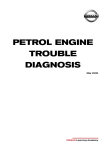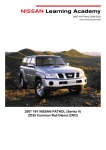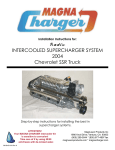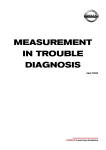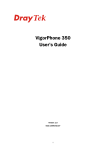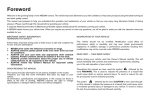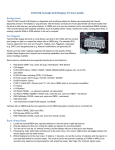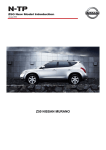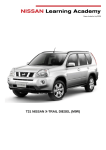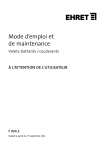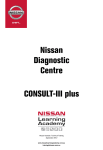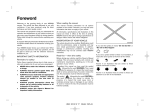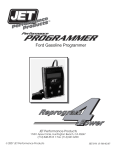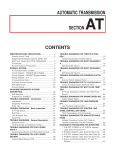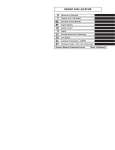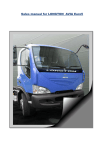Download diesel engine trouble diagnosis
Transcript
ENGINE TROUBLE DIAGNOSIS August 2009 Foreword The information in this Training Manual should not be interpreted as a basis for warranty or goodwill claims against Nissan Motor Co. (Australia) Pty. Ltd. (NMA) unless so designated. This Technical Training Manual is intended for use by NMA & Nissan Dealership Technical Personnel. It is not designed for the use by press or for customer distribution. Before quoting any specifications be sure to check the relevant Service Manual and Technical Bulletins. Right for alteration to data and specifications at any time is reserved. Any such alterations will be advised by Nissan through Technical and Sales Bulletins. ©2009 Nissan Motor Company (Australia) Pty. Ltd. Inc. Victoria Ref: Technical Training Department. Engine Trouble Diagnosis. Nissan Australia August 2009 PETROL ENGINE TROUBLE DIAGNOSIS Check In STEP 1 STEP 2 STEP 2a Verify on the vehicle what the incident is & compare to what is described by the Customer Can’t Fault it? STEP 3 Are there any Fault Codes (DTC’s)? STEP 4a STEP 5a No The fault is basic. FUEL. AIR. SPARK. POWER. GROUND Yes STEP 5b STEP 4b 1. Refer to page in SM that is relevant to the DTC. 2. Inform TechLine of the fault and the actions that YOU have so far carried out & other info gathered if the problem persists. 1. Refer to Symptoms Matrix Chart in the SM in conjunction with the information on the following pages. 2. Inform TechLine of the fault and the actions that YOU have so far carried out & other info gathered if the problem persists. STEP 6 PRIOR TO COMPLETION OF REPAIR AND HANDING BACK TO THE CUSTOMER 1. Go through the checklist on the following page. Consider each item in the list in relation to the problem experienced – REGARDLESS if the problem is there or not! 2. Carry out the “IDLE AIR VOLUME LEARN” (IAVL) operation in “WORK SUPPORT”. Ensure “CMPLT” is achieved. 3. Carry out the “A/F ALPHA” inspection with CONSULT II in “DATA MONITOR (SPEC)” 4. Carry out the “B/FUEL SCHDL” inspection with CONSULT II in “DATA MONITOR (SPEC)” 5. Take vehicle on a thorough road test, re-check for any DTC’s & re-do IAVL on return from road test. (For earlier vehicles, carry out Base Idle, Ignition Timing check / adjust & Mixture Ratio Feedback inspection) 1 Engine Trouble Diagnosis. Nissan Australia August 2009 PETROL ENGINE TROUBLE DIAGNOSIS 1. POWER AND GROUND (more detail further on) (a) Battery – Is it charged? Can it hold a charge? Is it being charged? Does it pass a load test? (b) Alternator. Can it cope with high electrical loads? Switch on all accessories & check it’s output under load. (b) Condition of battery terminals? Fusible links are in good condition – terminals clean & tight? (c) Main ground connections are in good condition? (d) Fuses – they are in the correct place & OK? There are typically 3 x different locations where fuses are located. CHECK ALL LOCATIONS! HAS THE VEHICLE GOT DECENT POWER SUPPLY & GROUND CONNECTIONS? 2. FUEL (a) Is there Fuel in the tank? Who was the last to put Fuel in the tank? What kind of Fuel went into the tank? Run engine on known good fresh fuel if in doubt. (b) Fuel Pressure (1) – Measure it with a known good FP gauge & write the figures on the R/O. Measure the FP at idle & again under FULL LOAD. Ensure the tank pick-up, pump, filter, return system (if applicable) is OK. Refer to section EC – Basic Service in the Service Manual. (c) Fuel Pressure (2) – Can the system maintain a residual pressure with the Engine OFF? If the pressure drops away over 20min, where is it going? Back to the tank? Through leaking injectors or fuel pressure regulator diaphragm? Leaking injectors or F-P regulator will contribute to hard start & black smoke emission. 3. IGNITION SYSTEM (a) The CORRECT type of spark plugs for the engine are fitted? (b) Spark plugs are worn / due for replacement? (c) Ignition leads, distributor cap is in good condition? (d) Ignition coil unit, coil power supply, is coil ground connection OK? (A poor coil ground can cause premature coil failures) 4. COMPRESSION (Air) (a) Measure with a known good compression gauge & write the figures on the R/O. Do both a DRY & then followed by a WET compression check. Refer to section EM of the Service Manual for procedure. (b) Air intake system – Are their any air leaks? oil cap, dip-stick, throttle body gasket & bypass hoses, vacuum hoses fitted correctly? (c) Air intake system – Blockage or air flow interference? (d) Air outlet system (Exhaust) – Blockage? Leaking manifold gaskets or cracked exhaust manifold? (e) EGR & crankcase ventilations systems operating OK? 5. ENGINE MECHANICAL TIMING INDICATION SYSTEM (a) CKPS & CMPS signal plates functioning OK / Serviceable? Sensors mounted correctly? Flywheel has been fitted in the correct place? (b) Camshaft / Crankshaft timed correctly? Variable camshaft timing mechanism & timing chain condition OK? 6. ENGINE OIL, COOLANT & PREVIOUS WORK HISTORY HAS THE VEHICLE GOT A DECENT SERVICE HISTORY? (a) Oil level is correct? Is it over/under full? Due for changing? (b) Is it the correct grade / viscosity for the engine? (c) Coolant level & condition is OK? Genuine coolant used? Cooling system is functioning OK? (d) Have you got records of other PREVIOUS WORK HISTORY (Nissan dealer or Non Nissan Dealer), FITMENT OF NON GENUINE PARTS & AFTER MARKET ACCESSORIES? 2 Engine Trouble Diagnosis. Nissan Australia August 2009 PETROL ENGINE TROUBLE DIAGNOSIS Checklist Continued 7. NATS All keys start the car OK? Remove keys from key ring set & retry. Ensure there are no other electronic devices that interfere with NATS keys operation when starting. 8. ILLOGICAL INPUTS INTO THE ECM. (a) Whilst being driven as well as stationary, ensure that inputs such as “P/N Posi Sw” & “Brake Sw” are input correctly. For a complete reference list, refer to section B – EC (“TROUBLE DIAGNOSIS – CONSULT II Reference Value in Data Monitor Mode”) of the Service Manual. (b) If possible, drive the vehicle fitted with a “KNOWN GOOD” Mass Air Flow Sensor. 9. PRE-PROGRAMMED ECM FAILSAFE OPERATIONS. (a) Ensure the customer does NOT drive with the brake pedal applied. (Specifically on T31 & Y61 TB48) (b) Ensure that the brake pedal & brake pedal switches (Stop Lamp & ASCD cut) are correctly adjusted. Ensure the clutch pedal ASCD cut switch is correctly adjusted (where fitted) (c) Ensure the brake lights globes & associated circuit is functioning correctly. Inspect for open circuit brake light globes &/or wiring, connections & grounds are OK. (Specifically on N16 Hatch with ETC). 3 Engine Trouble Diagnosis. Nissan Australia August 2009 PETROL ENGINE TROUBLE DIAGNOSIS Basic Service 1. Idle Speed Check With CONSULT, select “ENGINE & then “DATA MONITOR” & view the idle speed by viewing “Engine Speed” in “Main Signals”) 2. Ignition Timing Inspection Given that the engine is installed with a CKPS monitoring the movement & position of the Crankshaft (flywheel) & a CMPS monitoring the movement & position of the inlet camshaft, the ECM has the ability to “see” where the Crankshaft is in relation to the Camshaft & adjust the timing by itself accordingly. Therefore it is NOT necessary to check the ignition timing at normal service intervals etc. HOWEVER, it maybe necessary to inspect the ignition timing as part of a Trouble Diagnosis procedure. If so desired, the actual Ignition Timing can be inspected in the traditional manner to ensure the CKPS & CMPS systems are operating correctly. As shown right, remove No. 1 ignition coil, install Special Service Tool (SST) # E7032 & check the ignition timing. The engine must be idling at operating temperature & ALL accessories OFF. Compare the reading seen by the timing light with the “Ignition Timing” reading in Data Monitor on CONSULT. Typical Scenario’s which may cause the Ignition timing to be out of specification; • The Driveplate / Flywheel has been removed & reinstalled in the wrong place. (1 bolt hole out etc.) • The inlet camshaft variable timing mechanism has jammed in the advanced or retarded position. Typically due the engine oil never being changed. • Foreign object has damaged the sensor pick-up ring on the Driveplate / Flywheel. Remove the starter motor or inspection plate to check inside the bell-housing. • Foreign object / material has damaged / obstructed the camshaft signal plate / sensor. • Idle Air Volume Learn (IAVL) hasn’t “Completed” (CMPLT) • “Target Ignition Timing Adj.” located in “WORK SUPPORT” in CONSULT is incorrectly set. NOTE: Y61 TB48 engines require inspection / adjustment of the ignition timing every 20,000km’s. 4 Only use the Timing Light adapter SST. NEVER use the loop wire in the harness. Engine Trouble Diagnosis. Nissan Australia August 2009 PETROL ENGINE TROUBLE DIAGNOSIS Basic Service 3. Accel’r Pedal Released Pos’n Learning & Throttle Valve Closed Pos’n Learning. THIS SIMPLE OPERATION IS CRITICAL! Ensure the time frame suggested above for each key position is observed. “10 sec” means 10 actual seconds on an accurate watch or stop watch. NOT 10 “mini” seconds or 10 “that’ll be right” seconds!! This 2 in 1 learning operation is an EXTREMELY important operation that MUST be carried out for any of the following reasons; • After the Reprogramming of an ECM – BUT BEFORE THE ENGINE IS STARTED!! • A new or substitute ECM is installed in the vehicle. (Along with reprogramming ALL of the NATS ignition keys. Make sure you get ALL THE KEYS from the owner / driver) • A new or substitute Throttle Body Unit is installed on the vehicle. • The existing throttle body unit is cleaned. • Battery power has been lost for a long period of time. • Prior to carrying the Idle Air Volume Learn (IAVL) operation. 5 Engine Trouble Diagnosis. Nissan Australia August 2009 PETROL ENGINE TROUBLE DIAGNOSIS Basic Service 4. Idle Air Volume Learn (IAVL) The completion of this operation in around 15 ~ 20 seconds is a good indication that the engine operation is OK. Reasons why the IAVL will not “CMPLT”. • Both Target settings found in “WORK SUPPORT” on CONSULT are not set to “0” • Engine is not at operating temperature. Even though the Engine may feel hot, make sure this temperature is indicated in “DATA MONITOR” on CONSULT. • Engine is too hot (above 90 deg C) • Poor Power Supply to ECM • Bad Ground Connections for ECM • An Electrical Load is ON. (Heater fan, lights, audio) • Switch inputs such as P/N Posi, Power Steering pressure are indicating that the transmission is in Neutral or the Power Steering system is under load. • There is a BASIC ENGINE MECHANICAL problem such as an intake system air leak, compression issues, fuel supply issues or ignition system issues. • The Accelerator Pedal Released Position Learning & Closed Throttle Position Learning has NOT been carried out properly. It may need to be repeated up to 20 times. • Throttle valve isn’t closed properly. Typically excessive carbon is fouling the operation of the throttle unit. 5. Fuel Pressure Check This is for engines that have a “Returnless” type of fuel system only. Ensure that there is a CONSTANT PRESSURE OF 350 kPa AT ALL TIMES - whilst the engine is idling, & under full load. The Fuel pressure should never vary. Check the following items if the Fuel Pressure is too LOW; • Blocked fuel pump pick-up / filter (the fuel filter forms part of the pump assembly) • Restricted fuel lines • Faulty fuel pressure regulator. (The pressure regulator also forms part of the fuel pump assembly) If the Fuel Pressure is too HIGH, replace the fuel pressure regulator. 6 For T31 QR25, carry out the “Closed Throttle Position Learn” procedure. For all other ETC engines, carry out the “Idle Air Volume Learn” procedure. Engine Trouble Diagnosis. Nissan Australia August 2009 PETROL ENGINE TROUBLE DIAGNOSIS Basic Service 6. Clearing the “Self Learn” Select “SELF LEARN CONTROL” from the work Support menu & then touch “CLEAR” This operation clears the LONG TERM A/F Alpha values stored in the ECM. This should be carried out after a major engine service or after the repair of an engine running fault. NOTE; • ALPHA reading below 100% (e.g; 75%) indicates that the engine is running TOO RICH • ALPHA reading above 100% (e.g; 125%) indicates that the engine is running TOO LEAN or has a missfire condition (not burning O2). 7 Engine Trouble Diagnosis. Nissan Australia August 2009 PETROL ENGINE TROUBLE DIAGNOSIS Basic Service 6. “A/F ALPHA” Inspection 6 cylinder engine displayed. 2 separate banks of cylinders. 4 cylinder has 1 bank. Procedure: 1. Road Test vehicle briskly for 10 km’s. Engine & Transmission should be at operating temperature. 2. Confirm that the IAVL can be successfully completed. 3. Ideally the vehicle should have more than 5000km’s on it. (Vehicle has been properly “run in”). 4. Ensure that the engine has been properly serviced. Ensure the correct grade / type of oil is in the engine & the level is correct. Ensure components such as spark plugs, air filter’s etc are serviceable / genuine parts. Ensure that the correct Part Numbered components have been installed. 5. Ideally the barometric pressure should be 98.3 – 104.3 kPa. 6. Ideally the atmospheric temperature is between 20 – 30 deg C. 7. Engine speed is idling, (The IAVL must have achieved a “CMPLT”). 8. With CONSULT select options in the following order; “ENGINE” – “DATA MONITOR (SPEC)” – “SELECTION FROM MENU” – “A/F ALPHA” (select the 2 of them for a 6 cyl engine. There are 2 banks of cylinders that need to be monitored) – “START”. The screen in the graphic above should now appear. 9. With the engine under the conditions requested in steps 1 ~ 6, what does the black bar indicator do? (i) Does it remain stable & central within the hashed area? (If so, all is OK. See next page for “B/FUEL SCHEDULE” inspection.) (ii) Does it move out of the hashed area below 100%? If so, see next page for “RICH” trouble indication. (iii) Does it move out of the hashed area above 100%? If so, see next page for “LEAN” trouble indication. 8 Engine Trouble Diagnosis. Nissan Australia August 2009 PETROL ENGINE TROUBLE DIAGNOSIS A/F ALPHA Indicates “RICH” (Well below 100%) Check the following Items: A/F ALPHA Indicates “LEAN” (Well above 100%) Check the following Items: • Engine Oil is contaminated with excessive fuel or it is the wrong viscosity or overdue for changing. Change engine oil & filter if in doubt. • Air Flow through the air intake is restricted, check for interference of airflow. • Fault with EVAP system (fuel is being drawn directly from fuel tank breathing system & entering inlet manifold.) • Leaking injectors. • Excessively high fuel pressure. • Fuel Pressure regulator is leaking fuel. Fuel entering combustion chamber via the vacuum hose connected to it. (This applies to engines with a return type fuel system only) • Try a known good Mass Air Flow Sensor. • Air Leaks before & after the throttle or in the Inlet Manifold. Gaskets, seals, hoses, cracks etc. • Air Leaks in the Engine. Gaskets, seals, rocker cover, oil cap, dip stick, rear main oil seal etc. • Air Leaks in Exhaust. Manifold gaskets, flange gaskets, cracks etc. • Engine is lacking Fuel. Fuel pressure is too low, pump output is poor, fuel filter / tank pick-up is blocked, hoses kinked / blocked or the pressure regulator not maintaining the pressure correctly. • Cylinder miss-fire due to bad spark. Worn / non genuine spark plug, faulty coil / coil connection / coil ground connection. • Cylinder miss-fire due to bad / no injector operation. (injector dribbling fuel, not spraying). • Interference with the airflow through the air intake. Possible blockage or modified air intake system. • Try a known good Mass Air Flow Sensor 9 Engine Trouble Diagnosis. Nissan Australia August 2009 PETROL ENGINE TROUBLE DIAGNOSIS 7. “B/FUEL SCHDL” Inspection (Base Fuel Schedule) Procedure: 1. Road Test vehicle briskly for 10 km’s. Engine & Transmission should be at operating temperature. 2. Confirm that the IAVL can be successfully completed. 3. Ideally the vehicle should have more than 5000km’s on it. (Vehicle has been properly “run in”). 4. Ensure that the engine has been properly serviced. Ensure the correct grade / type of oil is in the engine & the level is correct. Ensure components such as spark plugs, air filter’s etc are serviceable / genuine parts. Ensure that the correct Part Numbered components have been installed. 5. Ideally the barometric pressure should be 98.3 – 104.3 kPa. 6. Ideally the atmospheric temperature is between 20 – 30 deg C. 7. Engine speed is idling, (The IAVL must have achieved a “CMPLT”). 8. With CONSULT select options in the following order; “ENGINE” – “DATA MONITOR (SPEC)” – “SELECTION FROM MENU” – “B/FUEL SCHDL” – “START”. The screen in the graphic above should now appear. 9. With the engine under the conditions requested in steps 1 ~ 6, what does the black bar indicator do? (i) Does it remain stable and central within the hashed area? If so this is OK. See earlier page for “A/F ALPHA” inspection & check. If A/F ALPHA as well as B/FUEL SCHDL is OK, engine condition is normal. (ii) Does it move out of the hashed area below the indicated value? If so, see next page for “Fuel Delivery Increase” inspection. (iii) Does it move out of the hashed area above the indicated value? If so, see next page for “Fuel Delivery Decrease” inspection. 10 Engine Trouble Diagnosis. Nissan Australia August 2009 PETROL ENGINE TROUBLE DIAGNOSIS B/F SCHDL Indicates a Fuel Delivery Decrease Check the following Items: B/F SCHDL Indicates a Fuel Delivery Increase Check the following Items: Interference with Air Flow through the intake system: • Restriction of Air-Flow. • Blocked Air Filter. • Modified Air Intake System. Non standard components in Air Intake system have been fitted. • Valve clearances incorrect. • Engine Compression is not to spec. • Try a known good MAFS. Excessive Engine Friction: • High viscosity Engine Oil. Use correct grade of engine oil for the engine. • Engine Oil Level too high. • Engine Oil is overdue for changing. (High viscosity). • Excessive external drive belt tension. • Mechanical fault with engine. (High engine load required to turn engine) • Mechanical fault in Transmission. (High engine load required to drive transmission) Insufficient Combustion: • Valve clearances incorrect. • Valve Timing incorrect. (Correlation between camshaft & crankshaft is incorrect). • Intake Valve Timing Control mechanism fault. (Valve timing advance / retard unit could be jammed). Other: • Interference with the airflow through the air intake. Possible blockage or modified air intake system. • Try a known good MAFS. 11 Engine Trouble Diagnosis. Nissan Australia August 2009 ADR 81/01 FUEL CONSUMPTION TEST PROCEDURE THIS LABEL IS FITTED SO THAT THE CUSTOMER CAN COMPARE THE FUEL CONSUMPTION OF DIFFERENT VEHICLE MODELS. IT DOES NOT SUGGEST THE ACTUAL FUEL CONSUMPTION OF THE VEHICLE. ACTUAL FUEL CONSUMPTION OF THE ENGINE UNDER EVERYDAY DRIVING CONDITIONS IS TYPICALLY 15% ~ 34% HIGHER THAN THE FIGURE QUOTED ON THE LABEL. The ADR 81/01 Test Cycle (sourced directly from www.greenhouse.gov.au/fuelguide) The test cycle simulates an 11 km trip with an average speed of 33.6 km/h. Approximately two thirds of the test time simulates urban-stop-go driving where the average speed is 18.8 km/h with the final third of the test drive time being similar to driving on a highway with the vehicle driven to over 100 km/h. The vehicle used in the test exactly matches the vehicle as it appears in the new vehicle brochure. (I.E; NO ACCESSORIES ARE FITTED) 12 Engine Trouble Diagnosis. Nissan Australia August 2009 EFFECTS ON PETROL ENGINE FUEL ECONOMY Increased purchasing cost of Fuel. Rising fuel costs are giving the customer the belief that the vehicle is at fault. Especially if the customer adds fuel to the vehicle in set amounts of dollars every week etc. Towing. Roof Racks / Bars. Even though many Nissan vehicles have remarkable towing capacities – the fuel consumption will be greatly affected as a result of towing. Especially if the vehicle is towing something on or close to the maximum towing capacity. If roof racks or bars are fitted (with or without contents) this will greatly effect fuel consumption. Wrong Engine Oil / Poor Service History Modern engines are extremely sensitive to Engine Oil viscosity. Ensure that only Nissan 7.5W 30 engine is used. Irregular servicing will easily cause poor fuel consumption concerns as well. Incorrect Wheels / Tyres. Vehicle is Overweight &/or Modified. Aftermarket accessories Ensure that the original spec wheels & tyres are fitted to the vehicle in question. Increased rolling resistance will cause poor fuel consumption. Additional parts on the exterior of a vehicle such as roof racks and spoilers, or having the window open increases fuel consumption, in some cases by over 20%. Tyre Pressures. Driven in Auto / Lock mode (4WD / AWD). Incorrect Handbrake Adjustment. Ideally, the vehicle should be driven in 2WD at all times unless the road surface conditions are unstable. Ensure that the tyres are set to the correct specification & MAKE SURE the handbrake has NOT been over adjusted. Driveline Friction. Ensure the driveline is properly serviced. Transmission / Transfer / Final drive oils the correct type & are they set to the correct level? Ensure the brakes are not dragging. Driving Style / Driving Pattern. Carefully question the customer on their driving styles / patterns. - Short stop start trips only? - Aggressive driving style vs gentle? 13 Engine Trouble Diagnosis. Nissan Australia August 2009 DIESEL ENGINE TROUBLE DIAGNOSIS STEP 1 Check In STEP 2 STEP 2a Verify on the vehicle what the incident is & compare to what is described by the Customer Can’t Fault it? STEP 3 Are there any Fault Codes (DTC’s)? STEP 5a STEP 4a No Yes The fault is basic. FUEL. AIR. POWER. GROUND. STEP 5b STEP 4b 1. Refer to page in SM that is relevant to the DTC. 2. Inform TechLine of the fault and the actions that YOU have so far carried out & other info gathered if the problem persists. 1. Refer to Symptoms Matrix Chart in the SM in conjunction with the information on the following pages. 2. Inform TechLine of the fault and the actions that YOU have so far carried out & other info gathered if the problem persists. STEP 6 PRIOR TO COMPLETION OF REPAIR AND HANDING BACK TO THE CUSTOMER 1. ONCE AGAIN ensure that ALL of the items listed under the heading CHECK LIST & Diesel Basic Service discussed on the following 5 pages are in PERFECT order. 2. Take vehicle on a thorough road test, re-check for any DTC’s on return. 3. PLEASE UPDATE the TechLine contact 14 Engine Trouble Diagnosis. Nissan Australia August 2009 DIESEL ENGINE TROUBLE DIAGNOSIS Checklist 1. FUEL (a) Is there sufficient QUANTITY of Fuel being delivered to the pump? Blocked Filter or Lines? (b) Is there an acceptable QUALITY of Fuel being delivered to the Pump? Drain base of Filter & check for contaminated Fuel + Dirt &/or Water. Check for PETROL as well. (c) Is there air leaking into fuel prior to it reaching the pump? Refer to further on in this manual for more detail. ## Take a sample of Fuel & store it in a clean – air tight – container for future reference ## 2. AIR (a) Is there sufficient QUANTITY of Air being delivered to the Engine? Blocked Air Filter or Air Intake system? Faulty Air Intake Control Valve? Air Leaks between MAFS & Engine? (b) Is there an acceptable QUALITY of Air being delivered to the Engine? EGR valve stuck open? Refer to “EGR VOLUME CONTROL SYSTEM” check in section B – EC of the Service Manual. (c) Check that Exhaust System is not blocked (d) Check the Turbo Unit. Refer to “TC BOOST CONTROL SOLENOID VALVE” check in section B – EC of the Service Manual. Ensure there is a sufficient vacuum supply coming from the engine driven vacuum pump. Also refer to “TURBO CHARGER” checks in section EM of the Service Manual. (e) Check the Engine COMPRESSION with a KNOWN GOOD compression gauge. WRITE down the figures you measured. Follow the directions in section B – EM of the Service Manual. (f) Check that the “Crankcase Ventilation System“ as per the information in section B – EC (“ENGINE CONTROL SYSTEM”) of the Service Manual 3. POWER SUPPLY & GROUND CONNECTIONS (a) Check the Battery. Is it serviceable? Does the condition improve with a jumper battery connected? (b) Confirm the cranking speed (if no start). The engine should crank at a speed of at LEAST 160rpm. Use “DATA MONITOR & view the CKPS in CONSULT to verify the Engine Cranking Speed. (c) Check ALL of the ground connections, battery terminals, fuses & fusible links that relate to the ENGINE SYSTEM. Carry out the “POWER SUPPLY AND GROUND CIRCUIT” checks in section B – EC of the Service Manual. (d) Ensure the ECM relay is serviceable. (Especially for D22 ZD30 & Y61 TD42Ti) 4. ENGINE OIL, COOLANT & PREVIOUS WORK HISTORY HAS THE VEHICLE GOT A DECENT SERVICE HISTORY? (a) Oil level is correct? Is it over/under full? Due for changing? (b) Is it the correct grade / viscosity for the engine? (c) Coolant level & condition is OK? Genuine coolant used? Cooling system is functioning OK? (d) Have you got records of other PREVIOUS WORK HISTORY (Nissan dealer or Non Nissan Dealer), FITMENT OF NON GENUINE PARTS & AFTER MARKET ACCESSORIES? 15 Engine Trouble Diagnosis. Nissan Australia August 2009 DIESEL ENGINE TROUBLE DIAGNOSIS Checklist Continued 5. BASIC SERVICE ITEMS. All models; (a) Perform a fuel filter inspection, water drain & bleeding operation. (b) Perform the fuel aeration inspection. (c) For CRD engines - check that the “Injector Adjustment Value Registration” has been correctly entered into the ECM as outlined in section B – EC (“BASIC SERVICE”) of the Service Manual. YD models only; (d) Perform the “Fuel Pump Learning Value Clearing” as outlined in section B – EC (“BASIC SERVICE”) of the Service Manual. 6. ILLOGICAL INPUTS INTO THE ECM. (a) Whilst being driven as well as stationary, ensure that inputs such as “P/N Posi Sw” & “Brake Sw” are input correctly. For a complete reference list, refer to section B – EC (“TROUBLE DIAGNOSIS – CONSULT II Reference Value in Data Monitor Mode”) of the Service Manual. (b) If possible, drive the vehicle fitted with a “KNOWN GOOD” Mass Air Flow Sensor. 7. ENGINE MECHANICAL TIMING INDICATION SYSTEM. Is the Engine’s Static Timing OK? (Valve timing etc.) Timing Chains & associated drive components & CKPS / CMPS indication devices OK? Excessive or Insufficient Valve Clearances? Also refer to Check Item 2 on the previous page. SPECIAL NOTE FOR MANUAL TRANSMISSION R51 / D40 YD25 ENGINES; Ensure the Dual Mass flywheel is serviceable. If it has excessive backlash, it will trigger CKPS related faults. 8. NATS. Are all of the Keys working? Is there a foreign Electronic device on the Key Ring Set? Are the keys genuine parts? The RED Key / Car symbol in the Combination Meter will illuminate if there is a NATS related issue, however this is NOT always the case. 9. PRE-PROGRAMMED ECM FAILSAFE OPERATIONS. (a) Ensure the customer does NOT drive with the brake pedal applied. (Specifically on Y61 ZD30-CRD) (b) Ensure that the brake pedal & brake pedal switches (Stop Lamp & ASCD cut) are correctly adjusted. Ensure the clutch pedal ASCD cut switch is correctly adjusted (where fitted) 16 Engine Trouble Diagnosis. Nissan Australia August 2009 DIESEL ENGINE TROUBLE DIAGNOSIS Diesel Basic Service & Inspection 1 a. Fuel Filter, Bleeding & Water Drain In the event of trouble diagnosis on a diesel engine, a blocked fuel filter is the 1st item that must be checked for. The Fuel Filter design & construction is typically the same on ALL diesel engine models. There is a primer pump which is operated by hand on the top of the assembly & there is a facility to drain water on the base of the unit. Once water in the base of the filter reaches a certain level, a float will rise and close a switch circuit. This in turn will illuminate a light on the dash. See pictures right for the various “Water in Fuel” warning light possibilities. When draining the base, look for signs of contamination in the fuel. If in doubt remove the filter, empty contents into a CLEAN SEALABLE container & keep it for future reference. Light 1; Typically this warning light is found in NON Electronic Control Engine Models. However it is now utilised on Y61 & D22 with CRD engines + the T31 X-TRAIL M9R. Light 2; Typically this warning light is found in Electronic Control Engine Models. It is a dual purpose light. If the light illuminates intermittently or permanently, yet there are NO DTC’s, then check for water in the base of the Fuel Filter or a faulty switch. If there are DTC’s stored, follow normal diagnosis procedures to repair fault. HOWEVER, ensure the base of the filter is checked & drained regardless!! E.g; Y61 RD28ETi, Y61 & D22 ZD30DDTi, Y61 TD42ETi. 1. 2. Light 3; Currently this light in the RED MIL format is unique to R51 / D40 YD25DDTi variants. It is a separate light to the ORANGE MIL on the instrument cluster. NOTE; Some early production R51models will not have a sedimentor unit at all & there is no “Water in Fuel” switch installed in the Fuel Filter. Contact TechLine should you have any specific queries relating to this. 3. 17 Engine Trouble Diagnosis. Nissan Australia August 2009 DIESEL ENGINE TROUBLE DIAGNOSIS YD25 Fuel Filtration & Water in Fuel Warning Arrangement April ~ June 2005 R51 only June 05 ~ May 06 R51 & Spain D40 Ensure to drain water regularly as there is no Water Switch fitted. Ensure to drain water from both the Sedimentor & Fuel Filter. Water Switch fitted to base of Sedimentor June 2006 onwards R51 & Spain D40 All Thailand D40 & D22 Water Sensor included as part of filter assembly. If an ORANGE coloured “Diff Lock ON” light appears on some vehicles, (late ’06 production) this indicates Water in Fuel. Drain the water & report the incident to TechLine. Water Switch fitted to base of Filter 18 SPECIAL NOTE: D22 ZD30 Orange MIL (check engine light) is also the WIF warning. Engine Trouble Diagnosis. Nissan Australia August 2009 DIESEL ENGINE TROUBLE DIAGNOSIS Diesel Basic Service & Inspection 1 b. Fuel Filter, Bleeding & Water Drain For ALL DIESEL ENGINE VEHICLES, Ensure that the fuel filter is drained EVERY 10,000KM’S! If water collects in the base of the filter, the Water in Fuel warning light will illuminate to warn the driver of the water in fuel condition. There will be no DTC’s recorded in the ECM however. DTC’s will eventually be logged if the water in fuel condition is not quickly rectified. R51 & Spain D40 2. Air Filter & Inspection of Air Intake Ensure the Air Filter is serviceable. If it is lightly dusted it can be cleaned with compressed air as the element is a dry paper type. Other wise it should be replaced. Ensure the remainder of the air intake system (such as the intercooler behind the bumper) is free from; • Blockage • Leakage • Damage Especially considering the Intercooler that is mounted behind the front bumper. 3. DTC Inspection Using CONSULT, check for any DTC’s in ENGINE as well as any other system. PRINT OFF ANY DTC”s RECORDED IMMEDIATELY prior to taking any further action. Refer to the ESM for information about the codes. Refer to the list of “Possible Causes” to determine the MOST LIKELY cause of the fault. REMEMBER THE CODE COULD BE RELATED TO THE BASICS! Do NOT immediately blame expensive components. 19 Engine Trouble Diagnosis. Nissan Australia August 2009 DIESEL ENGINE TROUBLE DIAGNOSIS Diesel Basic Service & Inspection 4. DPF Pressure Difference Inspection Ensure that the DPF is not restricted excessively. Use CONSULT in ENGINE - DATA MONITOR to view the DIFF EXH PRES with the engine running as per the conditions outlined in the chart shown right. Refer to the DPF Training Manual for more detail. 5. Battery / Alternator / GROUNDS Given the engines high reliance on ELECTRICAL POWER, ensure that the source of this is in perfect order. • Clean / tight battery terminals • Battery can pass a load test • Alternator is charging properly - WHEN IT IS UNDER LOAD • Engine ground connections E21, E41, E61 & F7 REFER TO PAGES 70 – 74 OF THIS MANUAL FOR MORE DETAIL. 6. Fuel Pressure Use CONSULT in ENGINE – DATA MONITOR – ACT CR PRESS to determine the amount of fuel pressure in the rail. Do NOT loosen a fuel line at the injector or rail! REFER TO PAGE 15 & 30 OF THIS MANUAL FOR MORE DETAIL. 7. Turbo Boost Pressure / Mass Air Flow Use CONSULT III in ENGINE – DATA MONITOR – INTAKE/M PRES SE & MAS AIR/FL SE to determine the amount of air pressure (turbo boost) & airflow in the intake when the engine is starting, raced, under load. REFER TO PAGE 53 OF THIS MANUAL FOR MORE DETAIL. 8. Engine Compression Ensure that there is suitable compression. Follow the directions outlined in section EM of the ESM. 20 DPF engines only Engine Trouble Diagnosis. Nissan Australia August 2009 DIESEL ENGINE TROUBLE DIAGNOSIS Diesel Basic Service & Inspection 9. Pump Timing Inspection (TD, RD & QD Engines only). The static pump timing setting is critical for the above stated engines. Once set in the correct position, the electronically controlled pump timing mechanism can accurately control injection timing. Procedure; Refer to Basic Service in section EC of the appropriate Service Manual. SST number E7149 - Injection Pump Plunger Dial Gauge will be required for this operation. Special Note for Y61 RD28ETi; Ensure the thin metal plate that is attached to the rear of the timing belt pulley on the front of the crank shaft is properly secured. Remove the CKPS & check for movement of the plate with a screw driver. The plate should have 3 tangs on it for the 120 deg signal. Typical symptoms include an erratic idle & the timing reading (“ACT INJ TIMG”) in CONSULT DATA MONITOR reads very erratically. 10. Inspection for Fuel Aeration. A quick & simple inspection of the fuel entering the fuel pump should also be made part of a Diesel Engine trouble diagnosis activity. If there is air entering the fuel, numerous engine running problems will result. Procedure; Install a piece of clear hose between the fuel filter & the fuel pump inlet. After the installation of the hose, check for air bubbles in the fuel with the engine running at idle and then at 3500rpm. It is normal and acceptable to have small intermittent (1mm diameter) bubbles in the feed hose at idle & less frequent but larger bubbles at 3500rpm. If the amount of air bubbles seen in the hose exceed the described amount, there is an issue of air leakage into the Fuel system. Begin with inspecting all the hose fittings for looseness & the sealing of the sender unit in the tank. Contact TechLine for further information. Note 1; The check should be made after a “settling” period of approximately 2 minutes. Note 2; Use a 9mm internal diameter clear hose which is fuel compatible. 21 Engine Trouble Diagnosis. Nissan Australia August 2009 DIESEL ENGINE TROUBLE DIAGNOSIS CONSULT II or III Basic Service 1. Fuel Pump Learning Value Clearing (All YD25) The ECM has the capability to learn how to control the Fuel pressure in the Rail in order to match each Fuel Pumps unique characteristics. This is achieved via the control of the suction valve on the Fuel Pump after monitoring the Fuel Pressure sensor in the Fuel Rail. However it maybe necessary to clear this learnt value from the memory of the ECM after working on the Fuel system. This principle of learning the ideal Fuel Pressure & maintaining a unique setting for each engine is very much like the principle of Petrol engines learning & maintaining a unique A/F Alpha. This “CLEAR” function in CONSULT II can be found in ACTIVE TEST. Follow the directions outlined in section B – EC of the Service Manual A typical scenario that will require the “CLEAR” operation to be performed is after the repairs have been carried out; • A new Fuel Filter has been fitted (in any case) • Rectification of the following DTC’s; P0088, P0089, P0093, P1272, P1273, P1274, P1275. • After rectification of a fuel blockage issue • After rectification of a fuel aeration issue • After the HP Fuel Pump has been replaced • After Injectors &/or Fuel Rail has been replaced • Complaints of excessive fuel consumption / smoke emission. (Use this in conjunction with a thorough engine / driveline / vehicle inspection) SPECIAL “PUMP LEANT CLEAR” PROCEDURE 1. With engine idling, touch “CLEAR” on CONSULT & wait until “CMPLT” appears. 2. Touch “BACK” or back out of the screen to the Active test menu. 3. Switch off ignition (stop engine) for 15seconds. 4. Restart engine & idle. 5. Once again access the “Pump Leant Clear” in CONSULT. 6. With engine idling, touch “CLEAR” on CONSULT & wait until “CMPLT” appears. 7. Continually repeat these steps. Ensure the ignition OFF condition (step 3) is always carried out. TechLine may advise to try this up to 10 times. 8. Re-evaluate engine operation. 22 This screen in CONSULT II is located by 1st selecting ENGINE & then selecting ACTIVE TEST. “Active Test”. For C-III, Select Engine > Active Test > Pump Leant Clear. Engine Trouble Diagnosis. Nissan Australia August 2009 DIESEL ENGINE TROUBLE DIAGNOSIS Diesel Basic Service 2. Injector Adjustment Value Registration (All CRD engines) Each Injector will tend to have very slight differences between them with the amount of Fuel they deliver when an electrical current is applied to them. If the ECM was to apply exactly the same current to all 4 x injectors on the Engine, there will tend to be slight differences in the amount of Fuel each Injector delivers. Therefore once the Injector has been manufactured, a special resistance measurement is taken of the Injector. This measurement is converted into a special code & then printed on the top of the Injector. This code is entered into the ECM at the factory via a special scan tool. However if during service, 1 or more than 1 of the injectors are replaced, the code of the failed injector needs to be erased from the ECM & the code of the newly installed injector will need to be entered into the ECM. This operation is can be carried out easily using CONSULT. If the ECM is replaced, the codes of the already existent Injectors need to be entered into the ECM. Ensure the codes on CONSULT II screen match the code printed on top of each Injector CYL 1 CYL 2 CYL 3 CYL 4 23 Engine Trouble Diagnosis. Nissan Australia August 2009 EFFECTS ON DIESEL ENGINE FUEL ECONOMY Increased purchasing cost of Fuel. Rising fuel costs are giving the customer the belief that the vehicle is at fault. Especially if the customer adds fuel to the vehicle in set amounts of dollars every week etc. Towing. Roof Racks / Bars. Even though many Nissan vehicles have remarkable towing capacities – the fuel consumption will be greatly affected as a result of towing. Especially if the vehicle is towing something on or close to the maximum towing capacity. If roof racks or bars are fitted (with or without contents) this will greatly effect fuel consumption. Wrong Engine Oil / Poor Service History. Modern engines are extremely sensitive to Engine Oil viscosity. Ensure that only Nissan 10W 40 ACEA B3 Engine Oil is used (ZD30 & non DPF YD25). Irregular servicing will easily cause poor fuel consumption concerns as well. DPF equipped engines (YD25 in R51 / D40) must use 5W 30 ACEA C3 Low Ash type engine oil. Poor Quality Fuel. Modern Common Rail Diesel engines DEMAND to be ran on good quality diesel fuel. Bio Diesel is NOT good quality fuel. Incorrect Wheels / Tyres. Vehicle is overweight / Modified body / Aftermarket accessories. Ensure that the original spec wheels & tyres are fitted to the vehicle in question. Increased rolling resistance will cause poor fuel consumption. Additional parts on the exterior of a vehicle such as roof racks and spoilers, or having the window open increases fuel consumption, in some cases by over 20%. Air Intake System. Ensure that the correct type of air filter his installed & that it is relatively clean. Poorly designed snorkels etc also will cause poor fuel consumption issues. Tyre Pressures. Driven in Auto / Lock mode (4WD / AWD). Incorrect Handbrake Adjustment. Ideally, the vehicle should be driven in 2WD at all times unless the road surface conditions are unstable. Ensure that the free wheeling hubs are NOT LOCKED (D22 & Y61). Ensure that the tyres are set to the correct specification & MAKE SURE the handbrake has NOT been over adjusted. Driveline Friction. Ensure the driveline is properly serviced. Transmission / Transfer / Final drive oils the correct type & are they set to the correct level? Ensure the brakes are not dragging. Driving Style / Driving Pattern. Carefully question the customer on their driving styles / patterns. - Short stop start trips only? - Aggressive driving style vs gentle? 24 Engine Trouble Diagnosis. Nissan Australia August 2009 EFFECTS ON DIESEL ENGINE FUEL ECONOMY Incorrectly Coded Injectors. (YD25 & ZD30 CRD) Ensure that the codes printed on top of the injectors match the codes in the memory of the ECM. “ACTIVE TEST - FUEL PUMP LEANT CLEAR” (YD25 Denso CRD – R51, D40 & D22) Perform this action with CONSULT after every fuel filter replacement or as part of an excessive fuel consumption / smoke emission diagnosis. Poor Ground connections & Power supply. Always ensure that the ground connections are clean & tight. Especially for R51 & D40 YD25. 25 Engine Trouble Diagnosis. Nissan Australia August 2009 1. POWER CONNECTION CHECKS 1. Disconnect Battery. Negative 1st. Positive last. 2. Unbolt / Disconnect at each location shown above. Inspect for corrosion or poor contact. Ensure that ALL crimped connections are OK (no corrosion & crimped tightly). Rectify as necessary. Reconnect confirming that connection is clean & tight. 3. Reconnect Battery. Positive 1st, Negative Last. 26 Engine Trouble Diagnosis. Nissan Australia August 2009 2. GROUND CONNECTION CHECKS 1. Disconnect Battery. Negative 1st. Positive last. 2. Unbolt / Disconnect at each location shown above. Inspect for corrosion or poor contact. Ensure that ALL crimped connections are OK (no corrosion & crimped tightly). Rectify as necessary. Reconnect confirming that connection is clean & tight. 3. Reconnect Battery. Positive 1st, Negative Last. 27 Engine Trouble Diagnosis. Nissan Australia August 2009 R51 / D40 YD25 GROUND CONNECTION POINTS Main Grounds 1. Battery Negative & Main Body Ensure that the BOTH of the connections circled in the diagram are Clean & Tight. Remove, inspect & refit securely once cleaned to be sure. 2. Engine Block Ensure that the connection circled in the diagram is Clean & Tight. Remove, inspect & refit securely once cleaned to be sure. 3. Alternator Bracket Ensure that the connection circled in the diagram is Clean & Tight. Remove, inspect & refit securely once cleaned to be sure. 28 Engine Trouble Diagnosis. Nissan Australia August 2009 R51 / D40 YD25 GROUND CONNECTION POINTS Engine Control System Grounds Ensure that ALL of the Ground connections shown right are in GOOD CONDITION. Ensure they are Clean & Tight. 1. ECM Ground E21 This Ground is located adjacent to the ECM in the engine bay. Remember: The ECM outputs an EXTREMELY HIGH CURRENT to operate the Injectors. Therefore a GOOD GROUND connection is very important for reliable engine operation. 2. ECM Ground E41 This Ground is located under battery carrier. It can be accessed by the removal of the grill in many cases. Otherwise the battery needs to be removed. 3. ECM Ground E61 This Ground is located under Air Cleaner Housing. 4. TCM & A/F Ratio Sensor Heater Ground F7 or F59 This single Ground connection is the ONLY Ground connection for the Automatic Transmission. For DPF equipped vehicles the A/F Ratio Sensor heater also shares the same Ground connection. 29 Engine Trouble Diagnosis. Nissan Australia August 2009 CREATING GRAPHS WITH CONSULT II 3. 1. 2. 4. 5. 1. Touch; DATA MONITOR 7. 2. Touch; SELECTION FROM MENU. (Otherwise touch MAIN SIGNALS and then START for general items.) 3. Touch the items you would like to view / record. 4. Touch PAGE DOWN to see other items for selection. Each selected item is highlighted. 5. Then touch START 10. 12. 11. 8. 6. 6. Touch RECORD at the desired moment. 7. The timer begins countdown to 0% from 100% (not shown in pic) 1. Once count down to 0 is complete, above screen is displayed. 8. Touch; DISPLAY 9. 9. Touch until “Print Graph” is displayed. 10. Touch items that require graphing. 11. Touch double arrow to reveal other recorded items. 12. Touch “Print”. Printer will output graphs as shown over page. If a situation arises where a known DTC will automatically trigger AUTO RECORD, the machine can be set for MANUAL RECORD regardless of DTC or not. 1. Touch; SETTING 2. Touch; MANU TRIG. 3. (ONLY if required) Touch the double arrows to slow down the time the recording is taken. 30 2. 3. Engine Trouble Diagnosis. Nissan Australia August 2009 CREATING GRAPHS WITH CONSULT II Cut the print out into sections & lay out on sheet of paper. Attach with cello tape etc. Each graph section shows time from 0 seconds through until just over 6 seconds. A GRAPH A; Shows when IGN SW is turned from ON to CRANK . F Ensure base line of graph is aligned with all others. This shows the time from when RECORD was touched. DURING CRANKING G B GRAPH B; Show’s Battery Voltage status during ENGINE CRANKING . C D GRAPH F; Shows injection pulse width. During cranking the injectors open for just over 10ms. GRAPH C; Engine RPM throughout RECORD TIME. “RECORD” was touched prior to engine being cranked . H I GRAPH D; After engine was started, the accelerator was pressed briefly. WHEN ACCEL PEDAL WAS PRESSED GRAPH G; Shows voltage output from MAFS as it reacts to the increase of airflow. GRAPH H; Shows actual ignition timing activity. GRAPH I; Shows actual inlet camshaft timing activity. J E GRAPH E; The Electrically controlled throttle valve reacts to the movement of the accel pedal. START OF RECORDING; 0 Seconds, RECORD was touched GRAPH J; Coolant temperature remains stable throughout entire period. END OF RECORDING; After 6 seconds has lapsed From when RECORD was 1st touched 31 Engine Trouble Diagnosis. Nissan Australia August 2009 CONSULT III DATA MONITOR RECORD 1. Touch the word “Select” against the desired vehicle system. 2. Touch the “Data Monitor” Icon on the left of the screen 3. Highlight “ENGINE” & then touch “Select Monitor Item” Engine Trouble Diagnosis. Nissan Australia August 2009 CONSULT III DATA MONITOR RECORD 4 (i) Clear the pre selected Main Signals items by touching “Clear Monitor Item”. (ii) Highlight the desired items from the list on the screen. These are examples; ENG SPEED BATTERY VOLT ACCEL SEN 1 T P SEN 1 TURBO BST SEN 1 START SIGNAL (iii) Touch the “Setting” tab (circled right). (iv) Ideally the “Sampling Rate” should be slowed down from every 10ms to every 20ms. This can be done by selecting the drop down icon. (small circle). There maybe cases where the recording time needs to be extended. Otherwise leave set to 30 seconds so as not to make the graphs too large. (v) Adjust the trigger point. Move it to 80% post & 20% pre. (large circle / arrow) (vi) Touch “OK” on the bottom right of the screen & then touch “Start” once the screen returns to the “SELECT MONITOR ITEM SCREEN” The 2nd setting tab accesses the recording trigger condition settings. Un-select the DTC box if the ECM has a permanent DTC in it. Otherwise the recording will automatically start as a DTC is detected. 33 Engine Trouble Diagnosis. Nissan Australia August 2009 CONSULT III DATA MONITOR RECORD 5. Once prepared, touch “RECORD” on the bottom right of the screen to capture the activity of the engine. Watch the recording time bar graph (circled right). Recording stops at 100%. The example recording activity is basically as follows; (i) Touch record (ii) In less than a second start Engine & allow to idle for 1 second (iii) Race engine twice & allow to idle again until the end of recording. The above must be carried out as quickly as possible in order to maximise the recorded data on the graphs 6. Once the recording has stopped, touch the back arrow (top left of screen) once. A message appears on the screen (circled right) – Touch “Yes”. 7. (i) Add any text after the model code to make the file name unique (circled right). (ii) Highlight the desired data & then touch “Upload Data”. 34 All items that require recording are listed on the screen Engine Trouble Diagnosis. Nissan Australia August 2009 CONSULT III DATA MONITOR RECORD 8. (i) Touch “Sub”. The main Sub Mode screen will appear over the Data Monitor screen. (ii) Touch the “Data Control” Icon. 9. (i) Highlight the saved file (touch the text area) with the unique name previously given to the file. (ii) Touch “Display” in the bottom right of the screen. 10. (i) Once the next screen appears, select “Line”. This will change the recorded data from Numerical to Line graph. (ii) Ensure that the desired data is displayed. In this example the “START SIGNAL” switching from OFF to ON is clearly seen (large circle). This shows when the engine was cranked over. (iii) It’s possible to slide the data back in time to catch activity well before “RECORD” was touched. Use the small slider tab on the screen to do so. (small circle) 35 Engine Trouble Diagnosis. Nissan Australia August 2009 CONSULT III DATA MONITOR RECORD 11. (i) Touch “All items” button under the “PRINT” title on the RHS of the screen. A small window will then appear as shown right. (ii) Touch the “Save” button on the field that next appears, followed by OK. (otherwise select print to actually print the graphs onto paper.) 12. Once “Save” has been selected, the graphs are converted into images which can be easily viewed on any PC. The image files are sent to a specific folder in the C drive of the PC as follows; C:/Consult III/ApplicationData/Print Images Print Images folder Locate this folder on the CONSULT III & create a shortcut to the folder on the desktop. 13. THESE FILES CAN BE EASILY ATTACHED TO THE TECHLINE CONTACT. THERE IS NO NEED TO FAX GRAPHS TO TECHLINE ANY LONGER. The graphs show that once the engine was started, the accelerator pedal was press twice & then the engine returned to idle & then the recording finished. 36 Engine Trouble Diagnosis. Nissan Australia August 2009 37 Engine Trouble Diagnosis. Nissan Australia August 2009 38 Engine Trouble Diagnosis. Nissan Australia August 2009 ENGINE HOT START CRANKING TEST – R51 YD25 A/T. (Engine Normal). With Ign ON, “Record” touched on CONSULT II, then engine cranked, started & allowed to idle, then engine is switched OFF. CONSULT II Software used; AED06G 39 Engine Trouble Diagnosis. Nissan Australia August 2009 DRIVE TEST – R51 YD25 A/T. (Recorded over a period of 10 seconds). Engine already idling & gear lever is already in “D”, “Record” touched on CONSULT II, then driven under maximum acceleration until vehicle speed reached 70km/h. NOTE: Engine was already at operating temperature. (Approximately 88 deg C) CONSULT II Software used; AED06G The Higher the Differential Exhaust Pressure reading, the higher the level of PM in the DPF causing a blockage in the DPF. If Temperatures of 600 deg C + are shown, this would indicate that a Regeneration is being carried out automatically. 40 Engine Trouble Diagnosis. Nissan Australia August 2009 ENGINE RACE TEST – R51 YD25 A/T. (Recorded over a period of 10 seconds). Engine already idling in neutral, “Record” touched on CONSULT II, then accelerator is repeatedly pressed to the maximum position then released. NOTE: Engine was already at operating temperature. (Approximately 88 deg C) CONSULT II Software used; AED06G 41 Engine Trouble Diagnosis. Nissan Australia August 2009 42 Engine Trouble Diagnosis. Nissan Australia August 2009 ENGINE COLD START CRANKING TEST – Y61 ZD30 CRD M/T. (Engine Normal). With Ign ON, “Record” touched on CONSULT II, then engine cranked, engine then stalled so it was re-cranked, engine started & allowed to idle, then & engine raced twice. CONSULT II Software used; AED06G 43 Engine Trouble Diagnosis. Nissan Australia August 2009 ENGINE HOT START CRANKING TEST – Y61 ZD30 CRD M/T. (Engine Normal). With Ign ON, “Record” touched on CONSULT II, then engine cranked, started & allowed to idle, then & engine raced twice. CONSULT II Software used; AED06G 44 Engine Trouble Diagnosis. Nissan Australia August 2009 DRIVE TEST – Y61 ZD30 CRD M/T. (Recorded over a period of 1 minute). Engine already idling & already in 1st gear, “Record” touched on CONSULT II, then driven changing through all gears (from 1st, then 2nd, 3rd & finally 4th) until vehicle speed reached 62km/h. Then slowed down changing back gears & eventually brought to a stop. NOTE: Engine was already at operating temperature. (Approximately 88 deg C) 160MPa = 1600BAR = 23,000PSi CONSULT II Software used; AED06G 45
















































